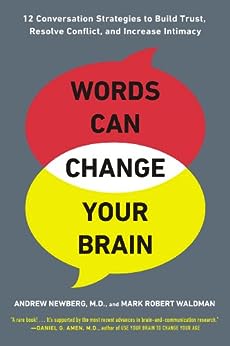Table of Contents
Introduction
Discover the conversational skills that have the potential to transform your life. We as human beings spend a significant portion of our lives interacting with one another using a range of methods, ranging from verbal to nonverbal communication, and this is one of the most important aspects of our existence.
(And don’t overlook the importance of texting and using emojis!) You may assume that given the variety of communication channels at our disposal, we would be very good at conveying the meaning of what we wanted to say.
On the other hand, this is not the case for the vast majority of people at all. The authors of the 2012 book “Words Can Change Your Brain” try to overcome this universal challenge by providing tactics that have been shown to improve communication abilities.

“WORDS CAN CHANGE YOUR BRAIN” SUMMARY
Let’s Start
That moment when you say something, thinking that you’ve said the perfect thing, only to be met by a frightened face from your discussion partner, is something that all of us have experienced at some point.
You realize too late that you have misspoken, that you have made the situation difficult, or even worse, that you have insulted them.
And a conversation that could have been productive and fruitful suddenly leaves you confused and desperate to backtrack as you try to explain what you meant to say.
Without a shadow of a doubt, this has to be one of the most excruciating sensations imaginable. And, sadly, it’s something that happens all too frequently.
However, the authors argue that things do not have to be this way at all! In the course of this brief, we will discuss the conversation tactics that can assist you in radically altering the ways in which you now practice communication.
Chapter 1
HOW COME COMMUNICATION IS SO HARD TO UNDERSTAND
When you think of it, do you ever consider communication an art form? The vast majority of us have not, and the authors point out that this is frequently where the issue first arises!
The majority of people have the misconception that they are already skilled communicators simply because talking is something that humans constantly engage in.
However, the findings of the authors’ research indicate that communication and talking are two entirely distinct activities. Consider, for instance, how difficult it is to have a conversation with a child who is only three years old.
The majority of toddlers are able to string together words sufficiently by the age of about two or three years, at which point they are able to communicate themselves to some degree.
They might not know the appropriate words for some things, and it might be challenging to understand them at times, but they have the fundamental skills that are necessary to explain what it is that they want.
But even though these basic skills are very important, they are not always enough to do a job well. Because no matter how much a young child talks, if we are unable to comprehend what it is that they are saying, it is difficult for there to be any kind of genuine conversation.
When your child is yelling a word over and over and you don’t understand what they mean, it may rapidly lead to a frustrating breakdown.
This is something that any parent knows all too well. The same is typically the case with adults who are attempting to speak with one another.
Adult communication problems often arise because we fail to utilize the appropriate words in the appropriate context, in contrast to toddlers, who often lack the vocabulary to adequately express themselves.
Consequently, this is the reason why it is essential to dedicate some of your time to improving your communication abilities. In addition, it is of the utmost importance to first appreciate the distinction between merely talking and actually communicating.
So, how does that actually play out in everyday life? You probably already know this, but if you’ve ever been yelled at in a fit of rage or been the recipient of someone else’s bad mood, you’ve been in a situation in which a person may have been trying to convey something — namely, their discontent — through the use of words, but they weren’t employing effective communication skills in the process.
The intention behind both speech and proper communication is one of the most significant contrasts between the two. When you’re just chatting with someone, it’s easy to blurt out whatever is on your mind, regardless of whether or not it’s the appropriate thing to say.
You could yell something like “Stop that!” or “Come here!” or “Are you an idiot?!” as an example.
In a similar way, you might find yourself using a lot of words that are very common but not very helpful. The expressions “Because I said so,” “You wouldn’t understand anyway,” “Never mind,” and “Rules are rules” are some prime instances of crucial examples.
The mere act of reading these statements reveals that each one of them has a tone that is either unfriendly or accusatory, and sometimes both. It’s possible that you’ve also observed that each one of them is a “shutdown statement.”
This indicates that they are preventing knowledge from being freely and openly shared. Each of the sentences that have been presented thus far is authoritative and provocative; it does not merely communicate an idea but also invites the other person to interact with what you have stated.
It can be helpful to think of them as sentences that tell you to “sit down and shut up”! If you are a parent or an employer, comments like “sit down and shut up” could occasionally be beneficial in helping you achieve the goal you have set for yourself.
In certain circumstances, you might want someone to simply sit down, stop talking, and move out of the way so that you can get anything done.
However, even if that is what you desire, communicating with someone in such a manner is never an effective use of one’s time.
Because even if these statements achieve what you want in the present, the damage they do to your relationships with other people and the hatred they foster are still a consequence of using them.
Therefore, if it’s in your power to do so, avoid using terms like “sit down and shut up”!
Chapter 2
WHAT EXCEPTIONS THERE ARE TO GOOD COMMUNICATION
If effective communication is the antithesis of comments that “shut down” dialogue, then what does it actually look like when it’s being put into practice?
And how exactly can you implement this into your day-to-day activities? Explaining things in a calm and clear manner is the cornerstone of effective communication, to put it in the simplest terms possible.
In point of fact, this is something that applies to the vast majority of situations; in order to have a productive conversation, regardless of the topic at hand, you should strive to present your knowledge in a composed and understandable manner.
Let’s have a look at some of the words that we discussed in the prior chapter as a practical illustration of how this concept operates in the real world.
Imagine that you had the nerve to tell your teenage daughter that she couldn’t attend a house party with her friends on a night while school was in session.
When she asks why or argues that she should be allowed to go, you might be tempted to respond with anything along the lines of “Because I said so!” or “Because rules are rules,” or “Never mind, you wouldn’t understand.”
But resist the urge. These comments, on the other hand, are not only useless but also a demonstration of weak communication abilities.
Therefore, instead of doing that, consider spending some extra time connecting with your daughter and explaining the issue to her.
Instead of saying “Because I said so,” try explaining that you don’t want you to attend the party because you don’t think it’s safe for you to go to a party where there is likely to be underage drinking and no adult supervision.
And even if the party is completely risk-free, I believe that it is not advisable for you to remain out late on a school night because you will wake up exhausted and irritable the next day.
I think it’s crucial to prioritize both school and your health, and if you don’t get enough rest, you’ll end up compromising not only your academic performance but also your emotional and physical well-being.
It might take a little bit more time and emotional investment, but in return, it gives a wide range of rewards to the person doing it.
To begin, you will be able to successfully reduce the level of tension in the conversation you are having with your daughter. Statements such as “You won’t understand” or “Rules are rules” generate friction because they belittle the intelligence of the other person and disrespect them from the very beginning of the interaction.
In contrast, when you discuss the problem in a calm manner, you are communicating that “I see you. I am treating you on the same level as others. You are deserving of both my attention and respect.
Therefore, you are laying the groundwork for constructive communication practices in the future when you successfully de-escalate the tension and express trust and respect to the other party.
This may appear to be a minor act, yet when individuals perceive that they are being disrespected, tension and resentment build up.
You probably don’t aim to encourage ill will and anger in your daughter when you respond with a statement that “shuts down” the other person’s argument.
Instead, I think you’re just attempting to wrap up this talk as quickly as possible. However, even if you didn’t intend to be cruel, there is a good chance that she will leave the conversation feeling angry and disrespected.
This is the case even if you didn’t intend to be harsh.
Therefore, the next time the two of you have a chat, that anger may be simmering just below the surface, even if the subject matter of the conversation is completely unrelated to the previous one.
In addition, if you continue this practice over the course of several different talks with your daughter, it is highly likely that you may permanently scar the patterns of communication that you have with her.
Is it not, therefore, worthwhile to spend a little bit of extra time and effort to explain the result?
Chapter 3
THE IMPORTANCE OF NONVERBAL COMMUNICATION IS DISCUSSED
Because this book focuses entirely on the power of words and communication, you probably aren’t giving much thought to the influence that your body language has on how effectively you communicate.
On the other hand, the author says that your nonverbal communication has a big effect on every conversation you have.
First, let’s examine the distinction between “open” and “closed” body language so that we may get a better grasp on the significance of this nonverbal form of communication.
It’s possible that you’re not familiar with the titles of these categories, but there’s no question that you can identify them when you encounter them!
Take, for example, a conversation you’re having with your teenage son about how much time he wastes playing video games in his room.
If he stands with his arms folded across his chest and rolls his eyes at everything you say, the message is very clear: he is distancing himself emotionally from you and cutting himself off from communication with you.
In a similar vein, if you are having lunch with your best friend and she stands up to greet you with open arms and a bright smile, you will know that her response to you is open and kind.
Therefore, when you find yourself face-to-face with a new person for the first time, keep these guidelines in mind! Don’t act as your crabby old teenager did; instead, utilize your body language to convey openness.
This could involve standing with your arms slack at your sides, which is a position that shows you are at ease with both yourself and other people, and with your body turned towards the other person in a way that is open and inviting.
You can communicate to the other person that you are interested in them and what they have to say by leaning ever so slightly towards them.
This not only fosters a cordial environment but also extends an invitation to the other person to feel comfortable in your company.
It is essential to have strong nonverbal communication skills since it is critical for your body language to correspond with the words you use.
Imagine you are interviewing a possible new employee to find out why this is so important. If the words coming out of their mouth are positive and appropriate, such as “Thank you so much for having me!
If someone told you, “I couldn’t be more thrilled about this opportunity!” what kind of body language would you anticipate from them?
Do you think it would be reasonable for you to anticipate them meeting you with a grin, a handshake, and nice eye contact? You would do that, wouldn’t you? What if, on the other hand, someone was to say,
“Thank you very much for having me! While staring you down and keeping their arms crossed over their chest, they exclaim, “I couldn’t be more thrilled about this opportunity!”
You’d probably feel pretty awkward! Why? Because their remarks aren’t supported by the way they carry themselves. You would find that contrast to be so weird, and as a result, you would have a very bad image of the candidate in question.
So, when you think about how important it is to communicate both verbally and nonverbally, it might help to keep this image in mind.
This will help you see why your words and your body language need to be consistent with one another. What should we do after we have an understanding of how important it is to communicate in a consistent manner and to use open body language?
What else can we do to ensure that the impression we provide with our body language is a positive one? The author believes that the next stage is to keep making direct eye contact with the person.
It goes without saying that you shouldn’t stare them down. If you maintain eye contact with them for too long without blinking, they might start to wonder if you have a spooky hidden dungeon in your basement!
Therefore, instead, make direct eye contact with someone for a few seconds while smiling. This merely conveys that you are aware of their presence and that you are upbeat and prepared to engage with them.
In addition to that, they will have a more favorable opinion of your intelligence as a result of this action.
This is something that we are aware of thanks to a study that was carried out in 2007 at Loyola Marymount University with the purpose of determining how eye contact influences initial judgments of a person’s level of intelligence.
The primary investigator, Nora A. Murphy, provided the following explanation for her findings: “Looking while speaking was a key activity.
It had a statistically significant correlation with IQ, was successfully influenced by impression-managing targets, and contributed to higher perceived intelligence ratings.
Murphy discovered, not unexpectedly, that one’s first perception of one’s level of intelligence can be improved by simply wearing spectacles.
Maintaining strong eye contact is essential, but glasses aren’t required if your vision isn’t impaired to the point where you need them.
Bear in mind that before either you or the other person even utters a word, all of these nonverbal factors will have already established the tone of the interaction.
Now that your nonverbal communication has made a good impression, it’s time to focus on what you say. Because this is the point at which the majority of individuals begin to falter, the single most crucial thing to keep in mind is this: don’t freak out!
Because they are afraid of saying something inappropriate, many people make fools of themselves right from the start, which makes them appear even more awkward than they already are. This is a classic case of self-inflicted wounds.
Therefore, whenever it is possible, try to avoid overthinking as well as other habits that can cause anxiety. Just stick to the fundamentals: flash a kind grin and say “Hi!” when you meet someone new.
” Hello, how are you? as well as your first name, of course. This is a quick way to break the ice and invite the other person to do the same by responding in kind.
And if, like a lot of other people, you’re concerned that you won’t remember their name, you may simply repeat it shortly thereafter in a casual way, such as by saying, “Allison.” It’s a pleasure to finally meet you, Allison!” You might even compliment their name if that comes more naturally to you, or you could include a personal tale such as, “Oh, I’ll definitely remember your name—my sister’s name is Allison!”
Chapter 4
CONCLUSION AND RECOMMENDATIONS
By now, the examples in this book should have shown you that talking and communicating are two completely different things.
Because of this, effective communication may be considered an art form. It is all about striking the correct balance between verbal and nonverbal communication in order to transmit your message in a way that is meaningful to another person.
Learning how to communicate effectively can be challenging, but with the correct resources and plenty of practice, anyone can improve their communication skills to a very high level.
The authors think that all you need to do is learn how to tell the difference between constructive and destructive ways to talk to people.
When you substitute words that are intended to “shut down” another person with answers that are calm and clear, you are able to talk to them rather than talking at them.
You may also make other people more receptive to what you have to say by using open body language and positive facial expressions. This will help them feel more at ease and allow them to focus on what you have to say.

”Widen The Window”(2019) Book Summary
Window ...A pioneering researcher provides us with a fresh understanding of stress and trauma in addition to the means to recover and thrive.

Buy this book @ Amazon:”Word Can Change Your Brain” 12 Conversation Strategies to Build Trust, Resolve Conflict, and Increase Intima cy Kindle Edition
Buy this book @ Amazon: ”What To Eat When”: A Strategic Plan to Improve Your Health and Life Through Food
Read more book summaries: “If a human has no direction, every wind is a fresh breeze” ― lenfantvivant
“Thought is only an abstraction representing a fraction of what is.” ― Lenfantvivant
”Widen The Window”(2019) Book Summary
Summary of “Atomic Habits” (2018)
:”Yes, And” Book Summary (2015)
Summary of:”No Matter Where You Go, There You Are ”By J. L. Mallory (2016)
Summary of “Atomic Habits” (2018)
“When You Die, Who Will Cry?” Book Summary For Robin Sharma (1999)
https://www.amazon.com.tr/Way-Zen-Alan-W-Watts/dp/0375705104
quotes in our website: https://psytify.com/quotes/
More quote resources: https://en.wikiquote.org/wiki/Main_Page


